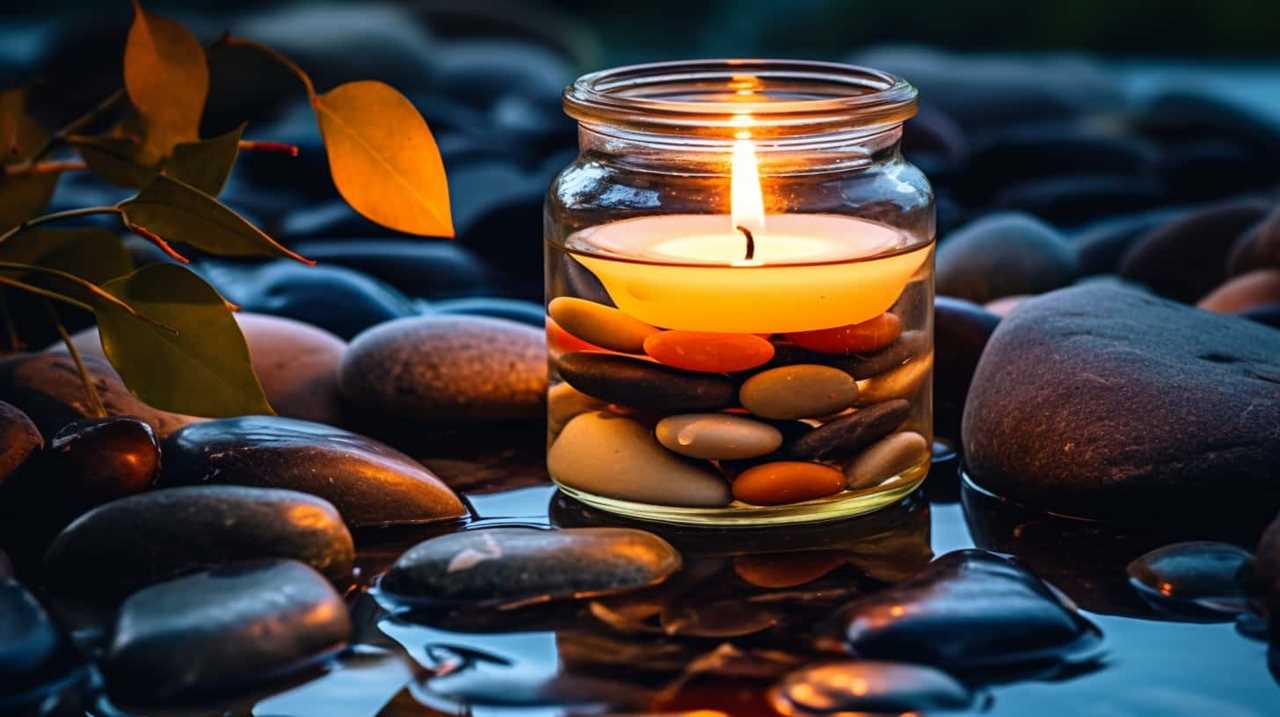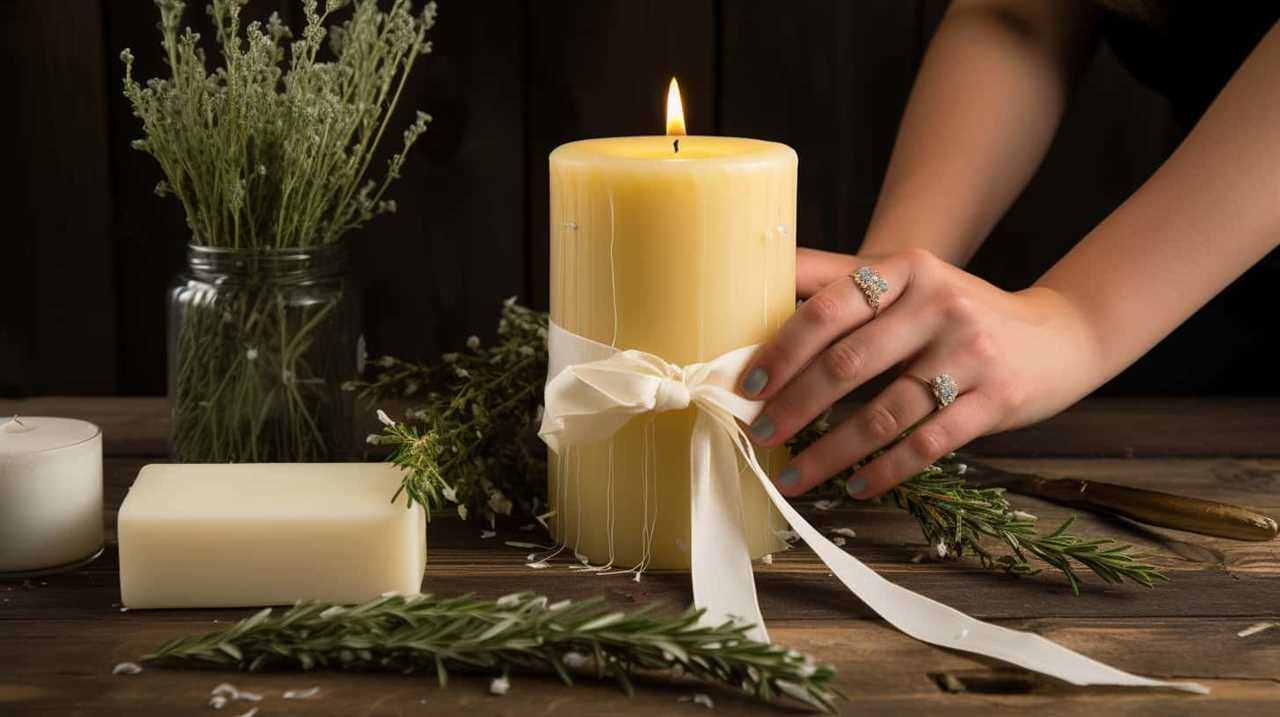Have you ever felt frustrated by a candle that burns down the center and leaves wax along the edges? Don’t worry, we’re here to help.
In this guide, we will show you how to fix a tunnelling candle and bring it back to its full glowing potential. With just a few simple steps, you’ll be able to enjoy a beautifully burning candle once again.
From assessing the extent of tunnelling to using a foil tent to redistribute the heat, we’ve gathered all the tips and tricks you need to know.
So, let’s grab our wick trimmers and get started on restoring your candle to its former glory.

Key Takeaways
- Adjust wick size, regularly trim, and ensure a full melt pool to troubleshoot tunnelling.
- Choose a well-balanced wax blend and provide proper air circulation to prevent tunnelling.
- Trim the wick to about 1/4 inch in length before each use to establish a burn pattern that prevents tunnelling.
- Burn the candle for at least one hour for every inch in diameter and avoid extinguishing before the wax has melted to the edge of the container to troubleshoot tunnelling.
Assess the Extent of Tunnelling
We assess the extent of tunnelling by examining the depth and width of the tunnel formed in the candle. Tunnelling occurs when a candle burns unevenly, leaving a tunnel in the center and wasting the outer wax.
To assess tunnelling causes, we need to consider factors such as wick size, wax type, and burning conditions. A too-small wick can lead to insufficient heat, resulting in tunnelling. Likewise, using a high-density wax can cause the candle to burn faster and create tunnels.
Troubleshooting tunnelling issues involves adjusting the wick size, trimming it regularly, and ensuring the candle burns long enough to create a full melt pool. Additionally, choosing a well-balanced wax blend and providing proper air circulation can help prevent tunnelling in candles.
Trim the Wick to the Appropriate Length
To address the issue of tunnelling in a candle, it’s crucial to trim the wick to the appropriate length. Trimming the wick helps establish a burn pattern that prevents tunnelling and ensures an even and consistent burn.

Here are three key points to consider when trimming the wick:
- Use sharp scissors or a wick trimmer to cut the wick to a length of about 1/4 inch. This length allows for optimal combustion and prevents excessive smoke and soot.
- Trim the wick before each use to maintain the ideal length and remove any charred or mushroom-shaped debris.
- Avoid trimming the wick too short, as this can lead to a weak flame that struggles to melt the wax evenly, resulting in tunnelling.
Use a Wick Trimmer or Scissors
To trim the wick of a tunnelling candle, grab a wick trimmer or a pair of sharp scissors. Proper wick maintenance is essential for preventing candle waste and ensuring a clean, even burn. A wick trimmer is specifically designed for trimming candle wicks and has a unique angled blade that allows for precise cutting. Scissors can also be used, but make sure they are sharp to avoid fraying the wick. Here is a table summarizing the steps to trim the wick using either a wick trimmer or scissors:
| Steps to Trim the Wick |
|---|
| 1. Ensure the candle is extinguished and cooled. |
| 2. Hold the wick trimmer or scissors at a 45-degree angle. |
| 3. Trim the wick to about 1/4 inch in length. |
| 4. Remove any trimmed wick debris from the candle. |
Establish a Proper Burn Time for Your Candle
After trimming the wick, it’s important to establish a proper burn time for our candle. This step is crucial in troubleshooting tunnelling issues and ensuring an even burn.
To establish a proper burn time, follow these guidelines:

- Begin by lighting the candle and allowing it to burn for at least one hour for every inch in diameter. This ensures that the wax melts evenly across the entire surface.
- Avoid extinguishing the candle before the wax has melted all the way to the edge of the container. This can lead to tunnelling, where a hole forms in the center, wasting valuable wax and diminishing the candle’s lifespan.
- If your candle has already developed a tunnel, burn it for longer periods until the entire surface has melted. This will help reestablish an even burn and prevent further tunnelling.
By establishing a proper burn time, you can troubleshoot tunnelling issues and enjoy a longer-lasting, more efficient candle.
Now, let’s move on to the next step: burning the candle long enough to melt the entire surface.
Burn the Candle Long Enough to Melt the Entire Surface
To prevent tunnelling and ensure an even burn, there are a few key points to keep in mind.
First, preheating the candle before lighting it can help melt the entire surface more quickly.

Additionally, trimming the wick to the appropriate length will promote a consistent burn.
Lastly, using candle accessories like candle warmers or trays can help distribute the heat evenly and prevent tunnelling.
Prevent Tunnelling With Preheating
Before we begin, let’s warm up the candle by burning it long enough to melt the entire surface, thereby preventing tunnelling. Preheating benefits the candle by ensuring an even burn and maximizing its lifespan.
To avoid tunnelling, follow these steps:

- Burn Time: Allow the candle to burn for at least one hour for every inch in diameter. This ensures that the entire surface melts evenly, preventing the formation of a tunnel.
- Draft-Free Environment: Place the candle away from any drafts, such as open windows or vents. Drafts can cause an uneven burn and contribute to tunnelling.
- Trimming the Wick: Before each burn, trim the wick to a quarter of an inch. A longer wick can produce a larger flame, leading to excessive heat and tunnelling.
Trim Wick for Even Burn
To achieve an even burn and prevent tunnelling, we need to ensure that the candle is burned long enough for the entire surface to melt. Proper wick maintenance is essential for achieving this goal. A trimmed wick helps maintain a steady flame and prevents excessive smoke and soot.
Troubleshooting techniques for wick maintenance involve trimming the wick to a length of about 1/4 inch before each burn. This helps the flame burn evenly and prevent the formation of a tunnel. Additionally, gently straightening the wick before lighting can help promote an even burn.
By following these simple steps, you can ensure that your candle burns evenly and efficiently, maximizing its burn time and enjoyment.
Now, let’s explore how to enhance your candle experience with the use of candle accessories.

Use Candle Accessories
Let’s utilize candle accessories to ensure the candle burns long enough for the entire surface to melt. This is an essential step in candle care to prevent tunnelling and maximize the lifespan of your candle. Here are some alternative solutions that can help achieve this:
- Candle Snuffer: Using a candle snuffer helps to extinguish the flame without blowing, which can create uneven melting. This promotes an even burn and ensures that the entire surface melts.
- Candle Warmer: A candle warmer is a device that gently heats the candle from below, melting the wax evenly. This is especially useful for larger candles or jar candles that may not burn evenly on their own.
- Candle Toppers: These decorative accessories sit on top of the candle, creating a tunnel effect that helps the wax melt evenly. They also help to retain the fragrance and prevent the formation of a tunnelling effect.
Use a Candle Snuffer to Extinguish the Flame
Using a candle snuffer is an effective way for us to extinguish the flame and prevent any further tunneling. When it comes to candle safety, using a snuffer provides several benefits.
Firstly, it eliminates the risk of blowing hot wax or sparks onto nearby objects, reducing the chances of accidental fires.
Secondly, the snuffer allows us to extinguish the flame without creating smoke or splattering wax, maintaining a clean and tidy environment.

To use a candle snuffer, simply hold it above the flame and gently lower the snuffer over the wick until it’s completely covered. This deprives the flame of oxygen and causes it to extinguish.
Now, let’s move on to the next step and learn how to use a foil tent to redistribute the heat.
Use a Foil Tent to Redistribute the Heat
After extinguishing the flame with a candle snuffer, we can now address the issue of tunnelling by using a foil tent to redistribute the heat. A foil tent is a simple and effective solution that can help prevent tunnelling and ensure an even burn throughout the candle. Here are some benefits of using a foil tent:
- Reflects heat: The foil tent reflects the heat from the flame back towards the sides of the candle, promoting an even burn and preventing tunnelling.
- Easy to make: Creating a foil tent is quick and easy. Simply fold a piece of aluminum foil into a tent shape and place it over the candle.
- Cost-effective: Using a foil tent is a cost-effective alternative to purchasing specialized candle accessories.
By using a foil tent, we can tackle the issue of tunnelling and enjoy a longer-lasting, more evenly burning candle.

Now, let’s move on to the next solution: rotating the candle periodically while burning.
Rotate the Candle Periodically While Burning
To prevent tunnelling and promote even burning, it’s important to rotate the candle periodically while it’s burning. This simple action helps distribute the heat evenly throughout the wax, preventing the formation of a tunnel and ensuring that all the wax is utilized.
Prevents Tunnelling
One effective way to prevent tunnelling in a candle is by periodically rotating it while it’s burning. This simple practice ensures that the wax melts evenly and prevents the formation of a tunnel, where the wick can drown and the outer wax remains unused.
Here are a few key reasons why rotating the candle is crucial for preventing tunnelling:

- Promotes Even Wax Melting: By rotating the candle, the heat is distributed evenly, allowing the entire surface of the wax to melt consistently.
- Prevents Wasted Wax: Rotating the candle ensures that all the wax is utilized, reducing waste and maximizing burn time.
- Maintains Proper Wick Length: Regular rotation prevents the wick from becoming too long on one side, which can lead to uneven burning.
Promotes Even Burning
We regularly rotate the burning candle to ensure even burning and prevent tunnelling. This simple step is a crucial part of candle maintenance and helps to promote an even burn throughout the entire candle.
When a candle burns unevenly, it can create a tunnel-like effect, where the wax only melts in the center, leaving unused wax around the edges. By rotating the candle periodically while it’s burning, we can distribute the heat more evenly and prevent tunneling.
This ensures that the candle burns cleanly and efficiently, maximizing its burn time and preventing wastage. To rotate the candle, simply use a heat-resistant tool, such as a long-handled spoon or a candle snuffer, to gently push the melted wax towards the unlit side.
Increases Candle Lifespan
To extend the lifespan of your candle, rotate it periodically while it’s burning. This simple technique not only ensures even burning but also increases the candle’s fragrance and prevents wax wastage.

Here’s why rotating the candle is important:
- Enhances fragrance distribution: By rotating the candle, you allow the fragrance to disperse evenly throughout the room. This prevents the fragrance from becoming concentrated in one area, ensuring a consistent and pleasant scent throughout the space.
- Prevents tunneling: Rotating the candle helps prevent tunneling, a common issue where the wax burns down the center, leaving a thick tunnel of unused wax around the edges. Rotating the candle ensures that the wax melts evenly, maximizing its lifespan and preventing wastage.
- Maximizes burn time: By rotating the candle, you ensure that the flame burns the wax evenly, preventing it from burning too quickly on one side. This helps prolong the burn time of the candle, allowing you to enjoy its ambiance and fragrance for longer.
Store Your Candles Properly to Prevent Tunnelling
To prevent tunnelling in candles, properly store them. Proper candle storage is essential to maintain the quality and longevity of your candles. Improper storage can lead to common causes of tunnelling, such as uneven burning and wasted wax. Follow these guidelines to ensure you store your candles correctly:
| Guidelines for Proper Candle Storage |
|---|
| Keep candles in a cool, dry place |
| Store candles away from direct sunlight |
| Keep candles upright to prevent warping |
| Avoid storing candles near heat sources |
Frequently Asked Questions
How Do I Know if My Candle Is Tunnelling?
Signs of a tunnelling candle include a narrow wax tunnel forming down the center while the outer wax remains untouched. Prevention can be done by trimming the wick and allowing the candle to burn for longer periods.
What Causes a Candle to Tunnel?
Candles can tunnel when the wick is not properly maintained, causing uneven burning and wasted wax. To prevent tunnelling, trim the wick to ¼ inch before each use and allow the candle to burn long enough to create a full melt pool.

Can I Fix a Tunnelling Candle Without Trimming the Wick?
Alternatives and solutions for fixing a tunnelling candle without trimming the wick can vary. However, it is recommended to trim the wick to prevent further tunnelling and ensure an even burn.
How Long Should I Burn My Candle to Prevent Tunnelling?
To prevent tunnelling, we recommend burning your candle for at least two hours during each use. This allows the wax to melt evenly and prevents a tunnel from forming. Consistent burning time is crucial for proper candle maintenance.
Are There Any Specific Storage Tips to Prevent Tunnelling in Candles?
To prevent tunnelling in candles, proper candle storage is crucial. Store candles in a cool, dry place away from direct sunlight and drafts. Always trim the wick before lighting to ensure even burn and avoid tunnelling.
Conclusion
In conclusion, by following these simple steps, you can effectively fix a tunnelling candle.

- Trim the wick to the appropriate length.
- Establish a proper burn time.
- Use a foil tent to redistribute the heat.
Additionally, rotating the candle periodically while burning and storing them properly can prevent tunnelling.
Remember, with these techniques, you’ll never have to worry about your candle burning unevenly again. So go ahead, light up your space with confidence and enjoy the warm glow of a perfectly burning candle.










